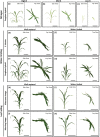Utilization of a high-throughput shoot imaging system to examine the dynamic phenotypic responses of a C4 cereal crop plant to nitrogen and water deficiency over time
- PMID: 25697789
- PMCID: PMC4378625
- DOI: 10.1093/jxb/eru526
Utilization of a high-throughput shoot imaging system to examine the dynamic phenotypic responses of a C4 cereal crop plant to nitrogen and water deficiency over time
Abstract
The use of high-throughput phenotyping systems and non-destructive imaging is widely regarded as a key technology allowing scientists and breeders to develop crops with the ability to perform well under diverse environmental conditions. However, many of these phenotyping studies have been optimized using the model plant Arabidopsis thaliana. In this study, The Plant Accelerator(®) at The University of Adelaide, Australia, was used to investigate the growth and phenotypic response of the important cereal crop, Sorghum bicolor L. Moench and related hybrids to water-limited conditions and different levels of fertilizer. Imaging in different spectral ranges was used to monitor plant composition, chlorophyll, and moisture content. Phenotypic image analysis accurately measured plant biomass. The data set obtained enabled the responses of the different sorghum varieties to the experimental treatments to be differentiated and modelled. Plant architectural instead of architecture elements were determined using imaging and found to correlate with an improved tolerance to stress, for example diurnal leaf curling and leaf area index. Analysis of colour images revealed that leaf 'greenness' correlated with foliar nitrogen and chlorophyll, while near infrared reflectance (NIR) analysis was a good predictor of water content and leaf thickness, and correlated with plant moisture content. It is shown that imaging sorghum using a high-throughput system can accurately identify and differentiate between growth and specific phenotypic traits. R scripts for robust, parsimonious models are provided to allow other users of phenomic imaging systems to extract useful data readily, and thus relieve a bottleneck in phenotypic screening of multiple genotypes of key crop plants.
Keywords: Cyanogenesis; LemnaTec Scanalyzer; Sorghum.; drought; growth; nitrogen deficiency; phenomics.
© The Author 2015. Published by Oxford University Press on behalf of the Society for Experimental Biology.
Figures







Similar articles
-
Response of millet and sorghum to a varying water supply around the primary and nodal roots.Ann Bot. 2013 Jul;112(2):439-46. doi: 10.1093/aob/mct099. Epub 2013 Jun 7. Ann Bot. 2013. PMID: 23749473 Free PMC article.
-
Evidence for the involvement of hydraulic root or shoot adjustments as mechanisms underlying water deficit tolerance in two Sorghum bicolor genotypes.J Plant Physiol. 2016 Mar 15;192:13-20. doi: 10.1016/j.jplph.2016.01.002. Epub 2016 Jan 8. J Plant Physiol. 2016. PMID: 26803215
-
Growth Properties and Biomass Production in the Hybrid C4 Crop Sorghum bicolor.Plant Cell Physiol. 2016 May;57(5):944-52. doi: 10.1093/pcp/pcv158. Epub 2015 Oct 27. Plant Cell Physiol. 2016. PMID: 26508521
-
Field crop phenomics: enabling breeding for radiation use efficiency and biomass in cereal crops.New Phytol. 2019 Sep;223(4):1714-1727. doi: 10.1111/nph.15817. Epub 2019 Apr 26. New Phytol. 2019. PMID: 30937909 Review.
-
Progress and challenges in sorghum biotechnology, a multipurpose feedstock for the bioeconomy.J Exp Bot. 2022 Jan 27;73(3):646-664. doi: 10.1093/jxb/erab450. J Exp Bot. 2022. PMID: 34644381 Free PMC article. Review.
Cited by
-
Improved Salinity Tolerance-Associated Variables Observed in EMS Mutagenized Wheat Lines.Int J Mol Sci. 2022 Sep 27;23(19):11386. doi: 10.3390/ijms231911386. Int J Mol Sci. 2022. PMID: 36232687 Free PMC article.
-
Deciphering the Genetic Mechanisms of Salt Tolerance in Sorghum bicolor L.: Key Genes and SNP Associations from Comparative Transcriptomic Analyses.Plants (Basel). 2023 Jul 13;12(14):2639. doi: 10.3390/plants12142639. Plants (Basel). 2023. PMID: 37514252 Free PMC article.
-
Novel Digital Features Discriminate Between Drought Resistant and Drought Sensitive Rice Under Controlled and Field Conditions.Front Plant Sci. 2018 Apr 17;9:492. doi: 10.3389/fpls.2018.00492. eCollection 2018. Front Plant Sci. 2018. PMID: 29719548 Free PMC article.
-
Setaria viridis as a Model System to Advance Millet Genetics and Genomics.Front Plant Sci. 2016 Nov 28;7:1781. doi: 10.3389/fpls.2016.01781. eCollection 2016. Front Plant Sci. 2016. PMID: 27965689 Free PMC article. Review.
-
Conventional and hyperspectral time-series imaging of maize lines widely used in field trials.Gigascience. 2018 Feb 1;7(2):1-11. doi: 10.1093/gigascience/gix117. Gigascience. 2018. PMID: 29186425 Free PMC article.
References
-
- Archontoulis SV, Miguez FE. 2013. Nonlinear regression models and applications in agricultural research. Agronomy Journal 105, 1–13.
-
- Arvidsson S, Perez-Rodriguez P, Mueller-Roeber B. 2011. A growth phenotyping pipeline for Arabidopsis thaliana integrating image analysis and rosette area modeling for robust quantification of genotype effects. New Phytologist 191, 895–907. - PubMed
-
- Berger B, de Reft B, Tester M. 2012. High-throughput phenotyping of plant shoots. Methods in Molecular Biology 918, 9–20. - PubMed
-
- Berger B, Parent B, Tester M. 2010. High-throughput shoot imaging to study drought responses. Journal of Experimental Botany 61, 3519–3528. - PubMed
-
- Blum A, Mayer J, Golan G. 1989. Agronomic and physiological assessments of genotypic variation for drought resistance in sorghum. Australian Journal of Agricultural Research 40, 49–61.
Publication types
MeSH terms
Substances
LinkOut - more resources
Full Text Sources
Other Literature Sources
Miscellaneous

